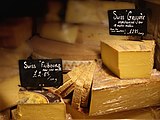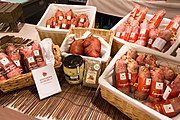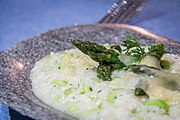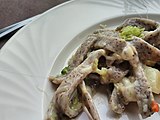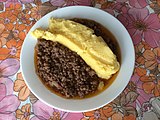Swiss Cuisine
Swiss cuisine (German: Schweizer Küche, French: cuisine suisse, Italian: cucina svizzera, Romansh: cuschina svizra) is an ensemble of national, regional and local dishes, consisting of the ingredients, recipes and cooking techniques developed in Switzerland or assimilated from other cultures, particularly neighboring countries.
The diversity and comprehensiveness of Swiss gastronomy reflects the linguistic, cultural and geographical diversity. The climate of Switzerland allows for a large variety of terroirs, and therefore a wide range of indigenous food, from simple cereals to refined products like cheese and wine.

Switzerland is historically an agricultural country, with many regions being isolated from each other by the Alps. Therefore, one of the main characteristics of Swiss cuisine is its simplicity, with many dishes made up of few but hearty ingredients, often of dairy origin. Swiss cuisine evolved dramatically during the last centuries. Probably the most significant changes occurred after colonization of the Americas and the introduction of now-widely-used ingredients such as potatoes, maize and cocoa. The increase in purchasing power and a certain homogenization of taste have allowed the emergence of some emblematic national dishes such as fondue and rösti.
Well-known products exported worldwide include cheese, wine and chocolate. A large number of them are protected by a geographical indication (AOP). A strong food industry, often related to chocolate, has developed over the past centuries in Switzerland.
Agriculture and foods
The climatic and cultural diversity of Switzerland is reflected in the diversity of its food products. Various cereals and fruits are cultivated in the lower regions, while the warmest and sunniest areas in the south lend themselves to growing grapes, chestnuts, and even olives. The other most common fruits cultivated in Switzerland are apples, pears, apricots, cherries, plums and strawberries. The mountainous and coldest areas feature the perhaps most emblematic agricultural practices of Switzerland: dairy farming and alpine transhumance.
Swiss cuisine comprises a variety of staple foods. These typically include bread, potatoes, pasta, rice and polenta. Potatoes are particularly ubiquitous in Swiss cuisine, although it is only the case since the late 18th century. They are notably used in rösti, a popular dish that is eaten all over Switzerland, and originally a breakfast food. Bread and cereals are eaten on a daily basis in Switzerland. Muesli, which is commonly eaten for breakfast goes by the name of "Birchermüesli" ("Birchermiesli" in some regions). For breakfast, most Swiss enjoy sliced bread with butter and jam; bread also accompanies most meals. There is a wide variety of breads made in Switzerland, from pain de seigle to Zopf. Tarts and quiches are also traditional Swiss dishes. Tarts in particular are made with all sorts of toppings, from sweet apple to onion.
Pork, poultry and beef are the most consumed meats in Switzerland. Pork is particularly omnipresent in Swiss cuisine; is it both consumed as cooked and cured meat. Swiss meat specialties are highly diversified: all sorts of pork sausages, bratwursts, smoked ham, salami, prosciutto, etc. Famous meat products include Grisons Meat (air-dried beef) and the "national sausage", cervelat. Fish is eaten in moderation, traditionally once in a week. Swiss lakes and rivers provide a small fraction of fish and shellfish consumed in the country. These include the popular perch and fera, which are served in lakeshore restaurants.
Foods associated with Switzerland often use milk as an essential ingredient; butter and cream are classic ingredients in Swiss cuisine. They notably include hard cheeses and chocolate. Swiss cheeses, in particular Emmental, Gruyère, Vacherin, and Appenzeller, are famous Swiss products. Two of the most popular Swiss dishes are fondue and raclette, which essentially consist of melted cheese accompanied with bread or potatoes. Chocolate is also strongly associated with Switzerland since the existence of milk chocolate, the Swiss chocolate industry being very flourishing since then.
Food preferences vary within Switzerland, often reflecting languages: the German-speaking north and east (the predominant linguistic area) has strong ties with Central Europe, whereas the French-speaking west and the Italian-speaking south tend to have more ties with Western and Mediterranean Europe. This applies notably to starchy foods, dairy products and fish. While potatoes, rice and pasta are commonly eaten everywhere in Switzerland, the proportion of pasta and rice is larger in the Italian-speaking regions. Conversely, fats like cream and butter are eaten in larger proportions in the German-speaking regions. Fish is also more commonly eaten in French- and Italian-speaking Switzerland. Those differences are also noticeable in wine and beer drinking habits.
History
The agrarian regions began to specialize towards the end of the Middle Ages, thus developing their own food pattern: in the Alpine regions, breeders fed on dairy products, cheese, nuts, berries, mushrooms, vegetables and fruits; on the Plateau, ploughmen fed on porridge, soups, bread, legumes, vegetables and, from time to time, wine. The diet varied greatly according to the seasons. Fresh garden vegetables gave way in winter to dried fruit and sauerkraut. The occasional famines forced the consumption of more acorns, beets, roots and breads made of substitutes.
The population boom of the early modern period led, while agricultural productivity stagnated, to an impoverishment of the diet (essentially based on porridge) and a decline in meat consumption. The supply was irregular, shortages and high prices frequent. However, the European colonization of the Americas led to the introduction of new food products, such as sugar and various fruits and vegetables. The 18th century finally experienced the food revolution which notably saw the introduction of potato, maize and cocoa. Maize spread to Ticino, the St. Gallen Rheintal and a few valleys in Graubünden, which adopted polenta for breakfast. Meanwhile, the potato was adopted as staple food in most regions of the country.
National dishes
A few dishes have become emblematic of Swiss cuisine and highly popular throughout the country. All of them have also become popular outside Switzerland's borders.
Muesli

Muesli, known in Switzerland as Birchermüesli, is a breakfast or snack consisting of cereal (oat) flakes, chopped fruit and milk. There are many ways of making a muesli, for example with honey, yoghurt and nuts. Muesli was created by the Swiss nutritionist Max Bircher-Benner in the early 20th century. His 'apple diet dish', developed as part of a raw food diet, was originally served to sanatorium patients as an easily digestible evening meal. After the Second World War, muesli became very popular throughout Switzerland thanks to home cooking courses and being served to the armed forces. Nowadays muesli is a staple in Western breakfast culture and is especially popular among athletes as a nutritional supplement.
Rösti
Rösti is a kind of fried potato cake served as a main course or side dish. As a main dish, rösti is usually accompanied with cheese, onions and cold meat or eggs. This dish, originally from Zürich, was first simply made by frying grated raw potatoes in a pan. It has then spread towards Bern where it is made with boiled potatoes instead. This is where it took the name Rösti. There are many variants in Switzerland and outside the borders. This culinary specialty gives its name to the röstigraben, which designates the cultural differences between the German- and French-speaking parts of the country.
Fondue and raclette

Fondue is a dish of usually several hard cheeses, such as Gruyère and Vacherin, which are melted with white wine and eaten hot with bread. It is served in a caquelon in which each guest dips their piece of bread using a special fork. At the base of the fondue pot is the heat source (stove or candles). Fondue was first described in 1699 in a Zürich manuscript by Albert Hauser. It is entitled To cook cheese with wine and resembles the recipe of today. Fondue was also promoted by the Swiss Cheese Union in the early 20th century. Today, it is often considered to be the national dish.
Raclette is also a dish of melted cheese, originating from Valais. Traditionally, half a cheese wheel is heated on the cut side and, as it melts, the cheese is scraped off onto a plate. Now, this is often performed using an electric appliance. Raclette is served with skin-on potatoes and mixed pickles, and often accompanied by Fendant as a drink. Melting cheese in front of a fire is attested in the 16th century. Since 1875, the French term raclette is commonly used for this dish. At the 1909 Cantonal Exhibition of Sion, raclette was promoted as a national dish of Valais. Raclette eventually gained national (and international) popularity from the 1964 National Exhibition.
Contrary to muesli and rösti, fondue and raclette are not meant to be staple foods, but rather convivial dishes intended for special occasions. Both fondue and raclette are especially popular during cold weather and have become associated with mountain culture and winter sports.
Regional cuisine
This section needs additional citations for verification. (May 2010) |
From the German-speaking part of Switzerland



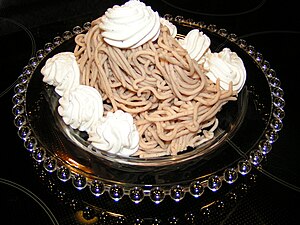


- Aargauer Rüblitorte mit Zitronenzuckerguss (AG): Carrot cake, a baked sponge cake made of nuts and carrots. Often spread with a glaze made out of powdered sugar and lemon juice, and decorated with small carrots made of marzipan.
- Älplermagronen (Alpine herdsman's macaroni): This dish is a frugal all-in-one dish making use of the ingredients the herdsmen had at hand in their alpine cottages: macaroni, potatoes, onions, small pieces of bacon, and melted cheese. Traditionally Älplermagronen is served with applesauce instead of vegetables or salad.
- Appenzeller Käsefladen: The Appenzeller cheese tart, also called Chäsflade, is made with either a bread dough or a yeast dough. The topping consists of Appenzeller cheese, finely chopped onions, eggs, cream and milk, spices to taste.
- Appenzeller Mostbröckli
- Basler Mehlsuppe (BS): In Basel, flour soup has been eaten early in the morning of carnival since the 19th century. Flour is roasted dark and deglazed with broth. Often served with grated cheese.
- Basler Käsewähe (BS)
- Basler Läckerli
- Bauernbrot
- Berner Platte (BE)
- Berner Rösti (BE)
- Berner Lebkuchen (BE)
- Biber(li) (Appenzell): The Biber is a gingerbread specialty from the Appenzellerland. The large Biber, the actual Biberfladen, contain natural honey and are unfilled. Smaller Biber, called Biberli, are filled with an almond paste.
- Bündner Nusstorte (GR)
- Bündnerfleisch (GR)
- Emmental Apple Rösti (German: Emmentaler Apfelrösti: Made from old bread, apple, and sugar, this used to be a very popular sweet dish made from leftovers, since the ingredients were usually at hand and the preparation is very simple. The recipe comes from the Emmental ("Emmen Valley") in the canton of Bern, the home of the famous Emmentaler cheese.
- Fotzelschnitten: A variant of french toast. The exact origin of the name remains unclear (literally, Fotzel means "torn-off scrap of paper").
- Cholera (VS)
- Cholermus (OW)
- Cordon Bleu
- Fasnachtschüechli: Deep fried dough disks, often sprinkled with powdered sugar. Traditionally served at the carnival season.
- Fastenwähe (BS)
- Fleischvogel
- Gehacktes mit Hörnli: Minced meat in either tomato- or brown sauce, served over small elbow macaroni, sometimes with apple sauce on the side.
- Glarner Birnbrot (GL): Pear bread is a traditional pastry from the Swiss Alps and foothills of the Alps with a filling of dried pears. Besides pears, the filling contains raisins, tree nuts and often figs and dried apple slices. It is spiced with candied orange peel, candied lemon peel, coriander, cinnamon, star anise, anise, and cloves, as well as with marc, kirsch, or wine.
- Gnottene/Gottus (VS)
- Kalberwurst (GL): A sausage with a distinctive, creamy flavor that originated in the canton of Glarus, kalberwurst is made with veal, milk, ground crackers, and mild spices. It has a smooth texture and mild taste, and although most sausages are smoked, kalberwurst is not. It is often cooked with onions and gravy.
- Kappeler Milchsuppe: The so-called 'Kappel Milk Soup' is at the center of an important event in the history of Switzerland. In 1529, Zürich troops marched against the central Swiss cantons. According to the reports, the common foot people of the two armies took advantage of the time when the leaders were negotiating to fraternize and placed a large cooking pot on a fire in Kappel am Albis, exactly on the border between the two cantons. The Zugers are said to have contributed the milk and the Zürichers the bread for a milk soup, which was then eaten together by both armies.
- Landjäger: A semi-dried sausage traditionally made in Switzerland, but also in Southern Germany, Austria, and Alsace. It is popular as a snack food during activities such as hiking. It also has a history as soldier's food because it keeps without refrigeration and comes in single-meal portions. Landjäger tastes similar to dried salami.
- Innerschweizer Chäs-Chueche
- Innerschweizer Zigerkrapfen
- Luzerner Birrenbrot (LU)
- Luzerner Chügelipastetli (LU): Lucerne Chügelipastete is a regional pastry dish from Lucerne. The name is derived from the spherical shape (Chügeli = little balls) of most of the ingredients used. Oldest mentions of the dish date back to the 18th century. The basic form consists of a puff pastry filled with a ragout of meat, mushrooms and raisins.
- Luzerner Lebkuchen (LU)
- Magenbrot (BS)
- Meitschibei (BE)
- Meringue (Meiringen)
- Neuenburger Wurst im Schlafrock
- Nüsslisalat
- Nussstängeli: (Nut sticks) is a Swiss hazelnut pastry, ideal for dunking in a hot coffee.
- Osterfladen
- Rahmschnitzel
- Riz Casimir is a preparation of rice with curry sauce and minced pork blended with tropical fruits: pineapple, banana and cherries, sometimes with currant grape. It was first served in 1952 by the international chain of hotel and resorts Mövenpick.
- Nidelwähe: Similar to the 'Wähen' (swiss tarts), these are flat, round cakes with little dough. However, these tarts are filled with a mildly sweet and creamy filling of thick cream, which in Switzerland is called nidle or nidel, depending on the region.
- Nidwaldner Lebkuchen (NW)
- Ribel (Rheintal)
- Schenkele
- Schinkengipfeli(i): Popular small ham croissants, consisting of a ham mousse filling and puff pastry.
- Schwyzer Krapfen (SZ)
- St. Galler (Kalbs)bratwurst (Veal Sausage, SG)
- St. Galler Brot (SG)
- St. Galler Schüblig (SG)
- suuri Lääberli (Basel)
- Tirggel (ZH) are traditional Christmas biscuits from Zürich. Made from flour and honey, they are thin, hard, and sweet.
- Zopf (bread): There are dozens of types of bread in Switzerland. However, Zopf is a typical Swiss specialty for Sundays.
- Vermicelles
- Wähe/Kuchen/Dünnen/Fladen/Gateau
- Walliser Roggenbrot (VS)
- Schweizer Wurstsalat
- Wurzelbrot
- Zibelechueche (BE)
- Zuger Kirschtorte (ZG)
- Zürcher Geschnetzeltes (English: cut meat, Zürich style; French: émincé de veau a la Zurichoise). This dish typically consists of sliced strips of veal in a creamy white wine sauce. Zürcher Geschnetzeltes is often served with Rösti.
From the French-speaking part of Switzerland
- Brisolée (VS): roasted chestnuts served in autumn with local cheeses and meats
- Carac: A distinctively green-colored chocolate and shortcrust pastry
- Gâteau bullois: A walnut pie (comparable to the Bündner Nusstorte) with chocolate
- Malakoff: Fried cheese balls or sticks from the region of la Côte in the canton of Vaud.
- Meringue: A dessert made of whipped egg whites, traditionally accompanied by double Gruyère cream
- Papet Vaudois: the canton of Vaud is home to this filling dish of leeks and potatoes. It is usually served with saucisse au chou (cabbage sausage).
- Longeole: A sausage from the Canton of Geneva made of pork and filled with fennel seeds.
- Cardon argenté épineux genevois: This cardoon is only grown in the Canton of Geneva. Its origins come from Huguenot refugees from the south of France, and adapted to the colder climate of Geneva. It is part of Christmas festivities in many Geneva households, often eaten in the form of a gratin.
- Brisolée
- Meringue with double cream
From the Italian-speaking part of Switzerland
The Italian-speaking part of Switzerland essentially coincides with Ticino, but also with the southern valleys of Graubünden. Popular dishes are polenta and risotto, often accompanied by the Luganighe and Luganighetta, a type of artisan sausages. Typical food from Ticino can be found in a Grotto, the local type of restaurant. Chestnut is also a historical staple food of southern Switzerland. The chestnut tree, introduced there 2000 years ago, was referred to as the "bread tree". Another specific product of Ticino is olive oil; olive cultivation was revived in the late 20th century.
- Polenta: For centuries polenta was regarded as a meal for the poor. Corn was introduced to the south of what is now Ticino as long ago as the beginning of the 17th century, which led to a change in the monotonous cuisine. But it took another 200 years before polenta - at first made of mixed flour, only later of pure cornmeal - became the staple dish of the area.
- Risotto is another common dish from Ticino. It is made with either mushrooms, saffron or cheese. It is often accompanied with either cooked pork sausages (Luganighe) or other regional cured meats, like salami, coppa and prosciutto.
- Pizzoccheri is a type of short tagliatelle, a flat ribbon pasta, made with a blend of buckwheat flour and wheat flour. It is believed to have originated in Valtellina, a valley in the northern Italian region of Lombardy. They are also popular in Val Poschiavo, a side valley of Valtellina which belongs to the Swiss canton of Grisons.
- Bruscitti are an Italian and Swiss single-course meal of the Lombard, Piedmontese and Ticinese cuisines (Switzerland) based on finely chopped beef cooked for a long time. Other ingredients of the dish are butter, lard, garlic, pancetta and fennel seeds. At the end of cooking they are blended with well-structured red wines such as Barbera, Barolo or Gattinara. This dish is served with the polenta, risotto alla milanese or purée.
- Polenta
- Risotto
- Pizzoccheri
- Bruscitti served with polenta
From the canton of Graubünden

- Bündner Nusstorte: There are several different regional recipes for nut cake, but the most famous is probably the one from the Engadin valley in the canton of Graubünden.
- Chur meat pie
- Bündner barley soup: The most famous soup from Graubünden
- Capuns: Typical speciality of western Graubünden
- Maluns
- Pizokel with cabbage: Pizokel were eaten in a wide variety of ways. In some places when eaten by themselves they are known in Romansh as "bizochels bluts", or “bald pizokel”. If someone leaves a small amount of any kind of food on the serving dish for politeness's sake, in the Engadine this is called "far sco quel dal bizoccal", meaning more or less “leaving the last pizokel”.
Restaurants and haute cuisine

A large variety of restaurants can be found in Switzerland. The Stube, Stübli or Stiva (German and Romansh), Brasserie (French) and Osteria (Italian) typically serve simple and traditional dishes. This is even more the case in mountain restaurants or mountain huts.
A unique type of restaurant is found in Ticino: the Grotto. Grottoes are rustic eateries, offering traditional food, such as polenta. Authentic grottoes are old wine caves re-functioned into restaurants. Due to their nature they are mostly found in or around forests and built against a rocky background. Typically, the facade is built from granite blocks and the outside tables and benches are made of the same stone as well. Grottoes are popular with locals and tourists alike, especially during the hot summer months.
As a culinary hotspot in the middle of Europe where high-quality ingredients are readily available, Switzerland boasts a high number of luxury restaurants. It also has a long tradition of hospitality, which is reflected in the palace hotels found in numerous localities. In the 2018 Michelin Guide, Switzerland ranked first worldwide in terms of Michelin-starred restaurants per capita. As of 2022, four restaurants were awarded 3 stars: the Restaurant de l'Hôtel de Ville in Crissier, the Schloss Schauenstein in Fürstenau, the Cheval Blanc in Basel and the Memories in Bad Ragaz. Among famous Swiss chefs are Frédy Girardet and Anton Mosimann.
Beverages

Wine is produced in many regions of Switzerland, particularly the Valais, the Vaud, the Geneva, the Ticino, the Neuchâtel and the Zürich cantons. Wine economy notably shaped the landscapes of Valais and the Lavaux, which have the most extensive terraced vineyards. Riesling X Sylvaner is a common white wine produced in German-speaking parts of the country, while Chasselas is the most common white wine in the French-speaking parts of the country, where it can also be known as Fendant (in the Valais) and Perlan (in Geneva). Pinot noir is the most popular red grape in both the French-speaking and the German-speaking part, while this position is held by Merlot in the Italian-speaking part.
Beer is second to wine in terms of consumption among Swiss. The country has a long tradition of brewing, with significant domestic beer production and a growing craft brewing sector. Most contemporary large-scale breweries are in German-speaking Switzerland. The Feldschlösschen brewery in Rheinfelden dwarfs all others in the country in terms of output. Calanda brewery in Chur is the largest in Graubünden. Zürich hosts the country's largest beer festival annually, and has a number of microbreweries.

Absinthe is perhaps the most famous Swiss spirit. It is legally distilled again in its Val-de-Travers birthplace, in the Jura region of Switzerland. Long banned by a specific anti-Absinthe article in the Swiss Federal Constitution, it was legalized again in 2005, with the adoption of the new constitution. Swiss absinthe is exported to many countries, with Kübler and La Clandestine Absinthe amongst the first new brands to emerge. Wine and beer can legally be purchased by youths aged 16 and up. Spirits and beverages containing distilled alcohol (including wine coolers like Bacardi Breezer) can be bought at age 18.
Damassine is a liqueur produced by distillation of the Damassine prune from the Damassinier tree and is produced in the canton of Jura.
Bon Père William is a famous regional Swiss pear brandy containing 43% ABV. It is usually paired with fondue or raclette dishes or drunk after dinner, and sometimes poured into coffee alongside dessert. Some bottles are available with the full-size pear inside the bottle, grown with the bud placed in the bottle. There are many other types of regional brandies made from local fruit, the most popular being cherries (kirschwasser).
Rivella, a carbonated Swiss drink based on lactose, is one of the most popular drinks in Switzerland. Apple juice, both still and sparkling, is popular in many areas of Switzerland, as is apple cider. The chocolate drink Ovomaltine (also known as "Ovaltine") originates in Switzerland and enjoys ongoing popularity, particularly with young people. Aside from being a beverage, the powder is also eaten sprinkled on top of a slice of buttered bread.
Switzerland has the seventh highest per capita coffee consumption worldwide.
See also
- Culinary Heritage of Switzerland, an online encyclopedia of Swiss food
- Health in Switzerland
Notes and references
External links
This article uses material from the Wikipedia English article Swiss cuisine, which is released under the Creative Commons Attribution-ShareAlike 3.0 license ("CC BY-SA 3.0"); additional terms may apply (view authors). Content is available under CC BY-SA 4.0 unless otherwise noted. Images, videos and audio are available under their respective licenses.
®Wikipedia is a registered trademark of the Wiki Foundation, Inc. Wiki English (DUHOCTRUNGQUOC.VN) is an independent company and has no affiliation with Wiki Foundation.
